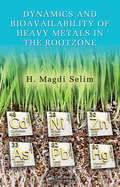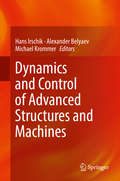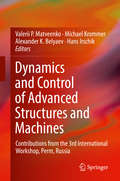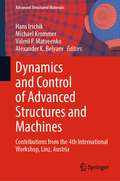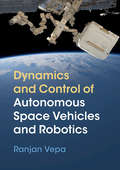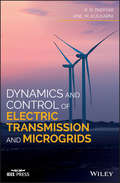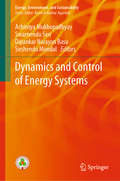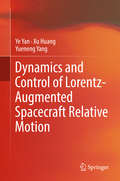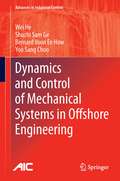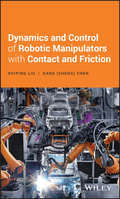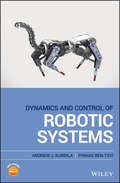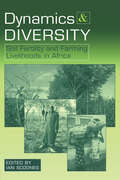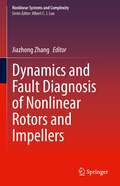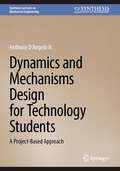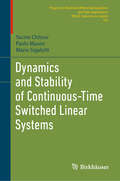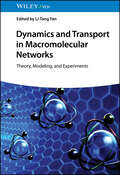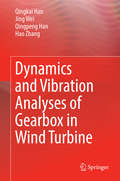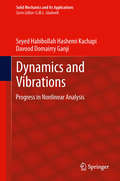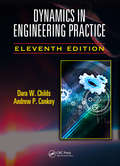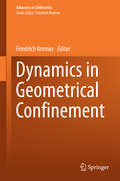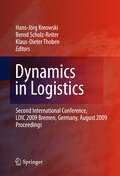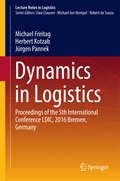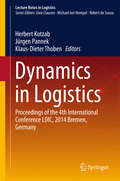- Table View
- List View
Dynamics and Bioavailability of Heavy Metals in the Rootzone
by H. Magdi SelimConcerns regarding heavy metal contamination in terrestrial ecosystems have prompted increasing efforts on limiting their bioavailability in the root zone. The complexity of the hydrologic system gives rise to the need for understanding the fate and transport of trace elements in the soil-water-plant environment. Dynamics and Bioavailability of Hea
Dynamics and Control
by G. Leitmann, F.E. Udwadia and A.V. KryazhimskiiThis multi-authored volume presents selected papers from the Eighth Workshop on Dynamics and Control. Many of the papers represent significant advances in this area of research, and cover the development of control methods, including the control of dynamical systems subject to mixed constraints on both the control and state variables, and the development of a control design method for flexible manipulators with mismatched uncertainties. Advances in dynamic systems are presented, particularly in game-theoretic approaches and also the applications of dynamic systems methodology to social and environmental problems, for example, the concept of virtual biospheres in modeling climate change in terms of dynamical systems.
Dynamics and Control of Advanced Structures and Machines
by Michael Krommer Hans Irschik Alexander BelyaevThe papers in this volume present and discuss the frontiers in the mechanics of controlled machines and structures. They are based on papers presented at the International Workshop on Advanced Dynamics and Model Based Control of Structures and Machines held in Vienna in September 2015. The workshop continues a series of international workshops held in Linz (2008) and St. Petersburg (2010).
Dynamics and Control of Advanced Structures and Machines: Contributions from the 3rd International Workshop, Perm, Russia (CISM International Centre for Mechanical Sciences #444)
by Alexander K. Belyaev Michael Krommer Hans Irschik Valerii P. MatveenkoThe volume includes 30 contributions from the 3rd International Workshop on Advanced Dynamics and Model Based Control of Structures and Machines representing the frontiers in the mechanics of controlled machines and structures. The Workshop, held in Perm, Russia in September 2017 continued a series of international workshops, starting in with the Japan - Austria Joint Workshop on Mechanics and Model Based Control of Smart Materials and Structures, the Russia - Austria Joint Workshop on Advanced Dynamics and Model Based Control of Structures and Machines and the first two editions of the International Workshop on Advanced Dynamics and Model Based Control of Structures and Machines. The previous workshops took place in Linz, Austria in September 2008 and April 2010, in St. Petersburg, Russia in July 2012 and in Vienna, Austria in September 2015. The up-to-date contributions are authored by internationally re-known leading experts in dynamics and control representing a broad spectrum of topics in the field of Advanced Structures and Machines; both, with respect to theoretical aspects as well as applications to contemporary engineering problems.
Dynamics and Control of Advanced Structures and Machines: Contributions from the 4th International Workshop, Linz, Austria (Advanced Structured Materials #156)
by Alexander K. Belyaev Michael Krommer Hans Irschik Valerii P. MatveenkoThis book presents selected contributions to the 4th International Workshop on Advanced Dynamics and Model Based Control of Structures and Machines. The workshop, which was held in Linz, Austria in September 2019, continued a series of international workshops — the Japan-Austria Joint Workshop on Mechanics and Model Based Control of Smart Materials and Structures, the Russia-Austria Joint Workshop on Advanced Dynamics and Model Based Control of Structures and Machines, and the first three editions of the International Workshop on Advanced Dynamics and Model Based Control of Structures and Machines. The chapters cover a broad spectrum of topics in the field of Advanced Structures and Machines both with respect to theoretical aspects as well as applications to contemporary engineering problems.
Dynamics and Control of Autonomous Space Vehicles and Robotics
by Ranjan VepaPresenting the established principles underpinning space robotics (conservation of momentum and energy, stability) with a thorough and modern approach, chapters build from general physical foundations through an extensive treatment of kinematics of multi-body systems, and then to conservation principles in dynamics. The latter part of the book focuses on real-life applications related to space systems. Drawing upon years of practical experience and using numerous solved examples, illustrative applications and MATLAB, the author includes: an explanation of basic space mechanics and the dynamics of space vehicles; a rigorous treatment of conservation and variational principles in dynamics and in control theory that can be applied to a range of space vehicles and robotic systems; and a systematic presentation of the application of dynamics and control theory to real spacecraft systems.
Dynamics and Control of Electric Transmission and Microgrids (Wiley - IEEE)
by K. R. Padiyar Anil M. KulkarniA guide to the latest developments in grid dynamics and control and highlights the role of transmission and distribution grids Dynamics and Control of Electric Transmission and Microgrids offers a concise and comprehensive review of the most recent developments and research in grid dynamics and control. In addition, the authors present a new style of presentation that highlights the role of transmission and distribution grids that ensure the reliability and quality of electric power supply. The authors — noted experts in the field — offer an introduction to the topic and explore the basic characteristics and operations of the grid. The text also reviews a wealth of vital topics such as FACTS and HVDC Converter controllers, the stability and security issues of the bulk power system, loads which can be viewed as negative generation, the power limits and energy availability when distributed storage is used and much more. This important resource: Puts the focus on the role of transmission and distribution grids that ensure the reliability and quality of electric power supply Includes modeling and control of wind and solar energy generation for secure energy transfer Presents timely coverage of on-line detection of loss of synchronism, wide area measurements and applications, wide-area feedback control systems for power swing damping and microgrids-operation and control Written for students of power system dynamics and control/electrical power industry professionals, Dynamics and Control of Electric Transmission and Microgrids is a comprehensive guide to the recent developments in grid dynamics and control and highlights the role of transmission and distribution grids that ensure the reliability and quality of electric power supply.
Dynamics and Control of Energy Systems (Energy, Environment, and Sustainability)
by Achintya Mukhopadhyay Swarnendu Sen Dipankar Narayan Basu Sirshendu MondalThis book presents recent advances in dynamics and control of different types of energy systems. It covers research on dynamics and control in energy systems from different aspects, namely, combustion, multiphase flow, nuclear, chemical and thermal. The chapters start from the basic concepts so that this book can be useful even for researchers with very little background in the area. A dedicated chapter provides an overview on the fundamental aspects of the dynamical systems approach. The book will be of use to researchers and professionals alike.
Dynamics and Control of Lorentz-Augmented Spacecraft Relative Motion
by Xu Huang Ye Yan Yueneng YangThis book develops a dynamical model of the orbital motion of Lorentz spacecraft in both unperturbed and J2-perturbed environments. It explicitly discusses three kinds of typical space missions involving relative orbital control: spacecraft hovering, rendezvous, and formation flying. Subsequently, it puts forward designs for both open-loop and closed-loop control schemes propelled or augmented by the geomagnetic Lorentz force. These control schemes are entirely novel and represent a significantly departure from previous approaches.
Dynamics and Control of Mechanical Systems in Offshore Engineering
by Shuzhi Sam Ge Wei He Bernard Voon Ee How Yoo Sang ChooDynamics and Control of Mechanical Systems in Offshore Engineering is a comprehensive treatment of marine mechanical systems (MMS) involved in processes of great importance such as oil drilling and mineral recovery. Ranging from nonlinear dynamic modeling and stability analysis of flexible riser systems, through advanced control design for an installation system with a single rigid payload attached by thrusters, to robust adaptive control for mooring systems, it is an authoritative reference on the dynamics and control of MMS. Readers will gain not only a complete picture of MMS at the system level, but also a better understanding of the technical considerations involved and solutions to problems that commonly arise from dealing with them. The text provides: · a complete framework of dynamical analysis and control design for marine mechanical systems; · new results on the dynamical analysis of riser, mooring and installation systems together with a general modeling method for a class of MMS; · a general method and strategy for realizing the control objectives of marine systems with guaranteed stability the effectiveness of which is illustrated by extensive numerical simulation; and · approximation-based control schemes using neural networks for installation of subsea structures with attached thrusters in the presence of time-varying environmental disturbances and parametric uncertainties. Most of the results presented are analytical with repeatable design algorithms with proven closed-loop stability and performance analysis of the proposed controllers is rigorous and detailed. Dynamics and Control of Mechanical Systems in Offshore Engineering is primarily intended for researchers and engineers in the system and control community, but graduate students studying control and marine engineering will also find it a useful resource as will practitioners working on the design, running or maintenance of offshore platforms.
Dynamics and Control of Robotic Manipulators with Contact and Friction
by Shiping Liu Gang S. ChenA comprehensive guide to the friction, contact and impact on robot control and force feedback mechanism Dynamics and Control of Robotic Manipulators with Contact and Friction offers an authoritative guide to the basic principles of robot dynamics and control with a focus on contact and friction. The authors discuss problems in interaction between human and real or virtual robot where dynamics with friction and contact are relevant. The book fills a void in the literature with a need for a text that considers the contact and friction generated in robot joints during their movements. Designed as a practical resource, the text provides the information needed for task planning in view of contact, impact and friction for the designer of a robot control system for high accuracy and long durability. The authors include a review of the most up-to-date advancements in robot dynamics and control. It contains a comprehensive resource to the effective design and fabrication of robot systems and components for engineering and scientific purposes. This important guide: Offers a comprehensive reference with systematic treatment and a unified framework Includes simulation and experiments used in dynamics and control of robot considering contact, impact and friction Discusses the most current tribology methodology used to treat the multiple–scale effects Contains valuable descriptions of experiments and software used Presents illustrative accounts on the methods employed to handle friction in the closed loop, including the principles, implementation, application scope, merits and demerits Offers a cohesive treatment that covers tribology and multi-scales, multi-physics and nonlinear stochastic dynamics control Written for graduate students of robotics, mechatronics, mechanical engineering, tracking control and practicing professionals and industrial researchers, Dynamics and Control of Robotic Manipulators with Contact and Friction offers a review to effective design and fabrication of stable and durable robot system and components.
Dynamics and Control of Robotic Systems
by Andrew J. Kurdila Pinhas Ben-TzviA comprehensive review of the principles and dynamics of robotic systems Dynamics and Control of Robotic Systems offers a systematic and thorough theoretical background for the study of the dynamics and control of robotic systems. The authors—noted experts in the field—highlight the underlying principles of dynamics and control that can be employed in a variety of contemporary applications. The book contains a detailed presentation of the precepts of robotics and provides methodologies that are relevant to realistic robotic systems. The robotic systems represented include wide range examples from classical industrial manipulators, humanoid robots to robotic surgical assistants, space vehicles, and computer controlled milling machines. The book puts the emphasis on the systematic application of the underlying principles and show how the computational and analytical tools such as MATLAB, Mathematica, and Maple enable students to focus on robotics’ principles and theory. Dynamics and Control of Robotic Systems contains an extensive collection of examples and problems and: Puts the focus on the fundamentals of kinematics and dynamics as applied to robotic systems Presents the techniques of analytical mechanics of robotics Includes a review of advanced topics such as the recursive order N formulation Contains a wide array of design and analysis problems for robotic systems Written for students of robotics, Dynamics and Control of Robotic Systems offers a comprehensive review of the underlying principles and methods of the science of robotics.
Dynamics and Control of Switched Electronic Systems
by Francesco Vasca Luigi IannelliThe increased efficiency and quality constraints imposed on electrical energy systems have inspired a renewed research interest in the study of formal approaches to the analysis and control of power electronics converters. Switched systems represent a useful framework for modeling these converters and the peculiarities of their operating conditions and control goals justify the specific classification of "switched electronic systems". Indeed, idealized switched models of power converters introduce problems not commonly encountered when analyzing generic switched models or non-switched electrical networks. In that sense the analysis of switched electronic systems represents a source for new ideas and benchmarks for switched and hybrid systems generally. Dynamics and Control of Switched Electronic Systems draws on the expertise of an international group of expert contributors to give an overview of recent advances in the modeling, simulation and control of switched electronic systems. The reader is provided with a well-organized source of references and a mathematically-based report of the state of the art in analysis and design techniques for switched power converters. Intuitive language, realistic illustrative examples and numerical simulations help the reader to come to grips with the rigorous presentation of many promising directions of research such as: converter topologies and modulation techniques; continuous-time, discrete-time and hybrid models; modern control strategies for power converters; and challenges in numerical simulation. The guidance and information imparted in this text will be appreciated by engineers, and applied mathematicians working on system and circuit theory, control systems development, and electronic and energy conversion systems design.
Dynamics and Diversity: Soil Fertility and Farming Livelihoods in Africa
by Ian ScoonesSoils are critical to agriculture and, in turn, to food supply and livelihoods. Sustainable management of soils is crucial for a large proportion of the population of Africa. Contrary to many claims, soil fertility is improved and managed successfully by small-scale farmers there. Careful studies from widely different areas reveal how closely bound up soil management is with complex social, cultural and ecological factors - requiring a far more subtly tuned approach to development policy and practice. This work is a study of how the context of livelihood systems has to inform development policy and practice.
Dynamics and Fault Diagnosis of Nonlinear Rotors and Impellers (Nonlinear Systems and Complexity #34)
by Jiazhong ZhangThis contributed volume presents recent developments in nonlinear dynamics applied to engineering. Specifically, the authors address stability and bifurcation in large-scale, complex rotor dynamic systems; periodic motions and their bifurcations in nonlinear circuit systems, fault diagnosis of complex engineering systems with nonlinear approaches, singularities in fluid-machinery and bifurcation analysis, nonlinear behaviors in rotor dynamic system with multi-mistuned blades, mode localization induced by mistuning in impellers with periodical and cyclic symmetry, and nonlinear behaviors in fluid-structure interaction and their control. These new results will maximize reader understand on the recent progress in nonlinear dynamics applied to large-scale, engineering systems in general and nonlinear rotors and impellers in particular.
Dynamics and Mechanisms Design for Technology Students: A Project-Based Approach (Synthesis Lectures on Mechanical Engineering)
by Anthony D´Angelo Jr.The book reviews the algebra, trigonometry, and basic calculus students need to be successful in solving problems. Next, a review of kinematics and Newton’s laws are discussed, and numerous examples are solved. Mechanisms include the slider crank, offset slider crank, gears and gear trains, belts and chains, and cams. A graphical and analytical approach is taken when covering slider crank mechanisms. The book uses vectors and Kennedy's theorem to solve a variety of included examples. Gears and gear trains as well as belts and chains are discussed. Finally, cams using graphical and analytical techniques are introduced. The concluding chapter gives multiple projects used in the class to capture the lectures and computer modeling using Excel and MATLAB.
Dynamics and Stability of Continuous-Time Switched Linear Systems (Progress in Nonlinear Differential Equations and Their Applications #105)
by Mario Sigalotti Yacine Chitour Paolo MasonLinear switched systems are a fascinating field of research, with many theoretical questions arising from applications which require sophisticated mathematical tools for their resolution. This monograph presents a unified theoretical approach for the analysis of stability of continuous-time linear switched systems, organizing and optimizing results scattered throughout literature. Emphasis is placed on the development of a rigorous and complete mathematical theory. In addition to fundamental tools such as common Lyapunov functions, converse Lyapunov theorems, and maximal Lyapunov exponents, the concept of Barabanov norm is also discussed. While this is now well understood from a theoretical point of view, it has not received much attention in more application-focused settings, likely because this fundamental object was developed in the context of arbitrary switches but has no immediate equivalent for classes of switching signals subject to various constraints (dwell time, persistent excitation, etc.). One of the aims of this text is to bridge this gap as far as possible by explaining how the main features of Barabanov norms can be generalized for classes of constrained switchings. Throughout the text, the authors maintain a general point of view, rather than treating classes of switching signals separately, by developing an axiomatic approach and identifying structural properties of these classes that allow crucial aspects of the Barabanov norm to be extended. This monograph will be a valuable resource for mathematicians and control engineers interested in continuous-time switched linear systems, as well as a definitive reference for more experienced researchers.
Dynamics and Transport in Macromolecular Networks: Theory, Modelling, and Experiments
by Li-Tang YanDynamics and Transport in Macromolecular Networks Comprehensive knowledge on concepts and experimental advancement, as well as state-of-the-art computational tools and techniques for simulation and theory Dynamics and Transport in Macromolecular Networks: Theory, Modeling, and Experiments provides a unique introduction to the currently emerging, highly interdisciplinary field of those transport processes that exhibit various dynamic patterns and even anomalous behaviors of dynamics, investigating concepts and experimental advancement, as well as state-of-the-art computational tools and techniques for the simulation of macromolecular networks and the transport behavior in them. The detailed text begins with discussions on the structural organization of various macromolecular networks, then moves on to review and consolidate the latest research advances and state-of-the-art tools and techniques for the experimental and theoretical studies of the transport in macromolecular networks. In so doing, the text extracts and emphasizes common principles and research advancement from many different disciplines while providing up-to-date coverage of this new field of research. Written by highly experienced and internationally renowned specialists in various disciplines, such as polymer, soft matter, chemistry, biophysics, and more, Dynamics and Transport in Macromolecular Networks covers sample topics such as: Modeling (visco)elasticity macromolecular and biomacromolecular networks, covering statistical and elastic models and permanent biomacromolecular networks Focus on controlled degradation in modeling reactive hydrogels, covering mesoscale modeling of reactive polymer networks and modeling crosslinking due to hydrosilylation reaction Dynamic bonds in associating polymer networks, covering segmental and chain dynamics and phase-separated aggregate dynamics Direct observation of polymer reptation in entangled solutions and junction fluctuations in crosslinked networks, covering tube width fluctuations and dynamic fluctuations of crosslinks A much-needed overview of developments and scientific findings in the transport behaviors in macromolecular networks, Dynamics and Transport in Macromolecular Networks is a highly valuable resource for chemists, physicists, and other scientists and engineers working in fields related to macromolecular network systems, both theoretically and experimentally.
Dynamics and Vibration Analyses of Gearbox in Wind Turbine
by Hao Zhang Jing Wei Qingkai Han Qingpeng HanThis book explores the dynamics and vibration properties of gearboxes, with a focus on geared rotor systems. It discusses mechanical theories, finite-element based simulations, experimental measurements and vibration signal processing techniques. It introduces the vibration-resonance calculation method for the geared rotor system in wind turbines and load sharing of the planetary gear train, and offers a method for calculating the vibrations of geared rotor systems under either internal excitations from gear sets or external loads transferred from wind loads. It also defines and elaborates on parameter optimization for planetary gear systems based on the torsional dynamics of wind-turbine geared rotor systems. Moreover, it describes experimental measurements of vibrations on the wind-turbine gearbox performed on the test rig and on site, and analyzes the vibration signals of different testing points, showing them in both time and frequency domains. Lastly, it lists the gear coupling frequencies and fault characteristic frequencies from the vibrations of the gearbox housing. The technologies and results presented are valuable resources for use in dynamic design, vibration prediction and analysis of gearboxes and geared rotor systems in wind turbines as well as many other machines.
Dynamics and Vibrations: Progress in Nonlinear Analysis
by Davood Domairry Ganji Seyed Habibollah KachapiDynamical and vibratory systems are basically an application of mathematics and applied sciences to the solution of real world problems. Before being able to solve real world problems, it is necessary to carefully study dynamical and vibratory systems and solve all available problems in case of linear and nonlinear equations using analytical and numerical methods. It is of great importance to study nonlinearity in dynamics and vibration; because almost all applied processes act nonlinearly, and on the other hand, nonlinear analysis of complex systems is one of the most important and complicated tasks, especially in engineering and applied sciences problems. There are probably a handful of books on nonlinear dynamics and vibrations analysis. Some of these books are written at a fundamental level that may not meet ambitious engineering program requirements. Others are specialized in certain fields of oscillatory systems, including modeling and simulations. In this book, we attempt to strike a balance between theory and practice, fundamentals and advanced subjects, and generality and specialization. None of the books in this area have completely studied and analyzed nonlinear equation in dynamical and vibratory systems using the latest analytical and numerical methods, so that the user can solve the problems without the need of studying too many different references. Thereby in this book, by the use of the latest analytic, numeric laboratorial methods and using more than 300 references like books, papers and the researches done by the authors and by considering almost all possible processes and situation, new theories has been proposed to encounter applied problems in engineering and applied sciences. In this way, the user (bachelor's, master's and PhD students, university teachers and even in research centers in different fields of mechanical, civil, aerospace, electrical, chemical, applied mathematics, physics, and etc.) can encounter such systems confidently. In the different chapters of the book, not only are the linear and especially nonlinear problems with oscillatory form broadly discussed, but also applied examples are practically solved by the proposed methodology.
Dynamics in Engineering Practice (Applied and Computational Mechanics)
by Andrew P. Conkey Dara W. ChildsObserving that most books on engineering dynamics left students lacking and failing to grasp the general nature of dynamics in engineering practice, the authors of Dynamics in Engineering Practice, Eleventh Edition focused their efforts on remedying the problem. This text shows readers how to develop and analyze models to predict motion. While esta
Dynamics in Geometrical Confinement
by Friedrich KremerThis book describes the dynamics of low molecular weight and polymeric molecules when they are constrained under conditions of geometrical confinement. It covers geometrical confinement in different dimensionalities: (i) in nanometer thin layers or self supporting films (1-dimensional confinement) (ii) in pores or tubes with nanometric diameters (2-dimensional confinement) (iii) as micelles embedded in matrices (3-dimensional) or as nanodroplets. The dynamics under such conditions have been a much discussed and central topic in the focus of intense worldwide research activities within the last two decades. The present book discusses how the resulting molecular mobility is influenced by the subtle counterbalance between surface effects (typically slowing down molecular dynamics through attractive guest/host interactions) and confinement effects (typically increasing the mobility). It also explains how these influences can be modified and tuned, e. g. through appropriate surface coatings, film thicknesses or pore diameters. "Dynamics in Confinement" sums up the present state-of-the-art and introduces to the analytical methods of choice for the study of dynamics in nanometer-scale confinement.
Dynamics in Logistics
by Bernd Scholz-Reiter Hans-Jörg Kreowski Klaus-Dieter ThobenThe volume comprises the proceedings of the third International Conference on Dynamics in Logistics LDIC 2012. The scope of the conference targeted the identification, analysis, and description of the dynamics of logistic processes and networks. The spectrum ranged from the modeling and planning of processes and innovative methods like autonomous control and knowledge management to the new technologies provided by radio frequency identification, mobile communication, and networking. The growing dynamics in the area of logistics poses completely new challenges: Logistic processes and networks must rapidly and flexibly adapt to continuously changing conditions. LDIC 2012 provided a venue for researchers from academia and industry interested in the technical advances in dynamics in logistics. The conference addressed research in logistics from a wide range of fields, e.g. engineering, computer science and operations research. The volume consists of two invited papers and of 49 contributed papers divided into various subjects including transport logistics, routing in dynamic logistic networks, modeling, simulation, optimization and collaboration in logistics, identification technologies, mathematical modeling in transport and production logistics, information, communication, risk and failure in logistic systems, autonomous control in logistic processes, global supply chains and industrial applications, and the Internet of Things in the context of logistics.
Dynamics in Logistics
by Jürgen Pannek Herbert Kotzab Michael FreitagThese proceedings contain research papers presented at the 5th International Conference on Dynamics in Logistics, held in Bremen, Germany, February 2016. The conference is concerned with dynamic aspects of logistic processes and networks. The spectrum of topics reaches from modeling, planning and control of processes over supply chain management and maritime logistics to innovative technologies and robotic applications for cyber-physical production and logistic systems. The growing dynamic confronts the area of logistics with completely new challenges: it must become possible to describe, identify and analyze the process changes. Moreover, logistic processes and networks must be redevised to be rapidly and flexibly adaptable to continuously changing conditions. The book primarily addresses researchers and practitioners from the field of industrial engineering and logistics, but it may also be beneficial for graduate students.
Dynamics in Logistics
by Jürgen Pannek Herbert Kotzab Klaus-Dieter ThobenThis contributed volume brings together research papers presented at the 4th International Conference on Dynamics in Logistics, held in Bremen, Germany in February 2014. The conference focused on the identification, analysis and description of the dynamics of logistics processes and networks. Topics covered range from the modeling and planning of processes, to innovative methods like autonomous control and knowledge management, to the latest technologies provided by radio frequency identification, mobile communication, and networking. The growing dynamic poses wholly new challenges: logistics processes and networks must be(come) able to rapidly and flexibly adapt to constantly changing conditions. The book primarily addresses the needs of researchers and practitioners from the field of logistics, but will also be beneficial for graduate students.
